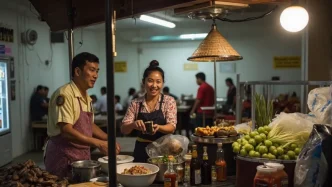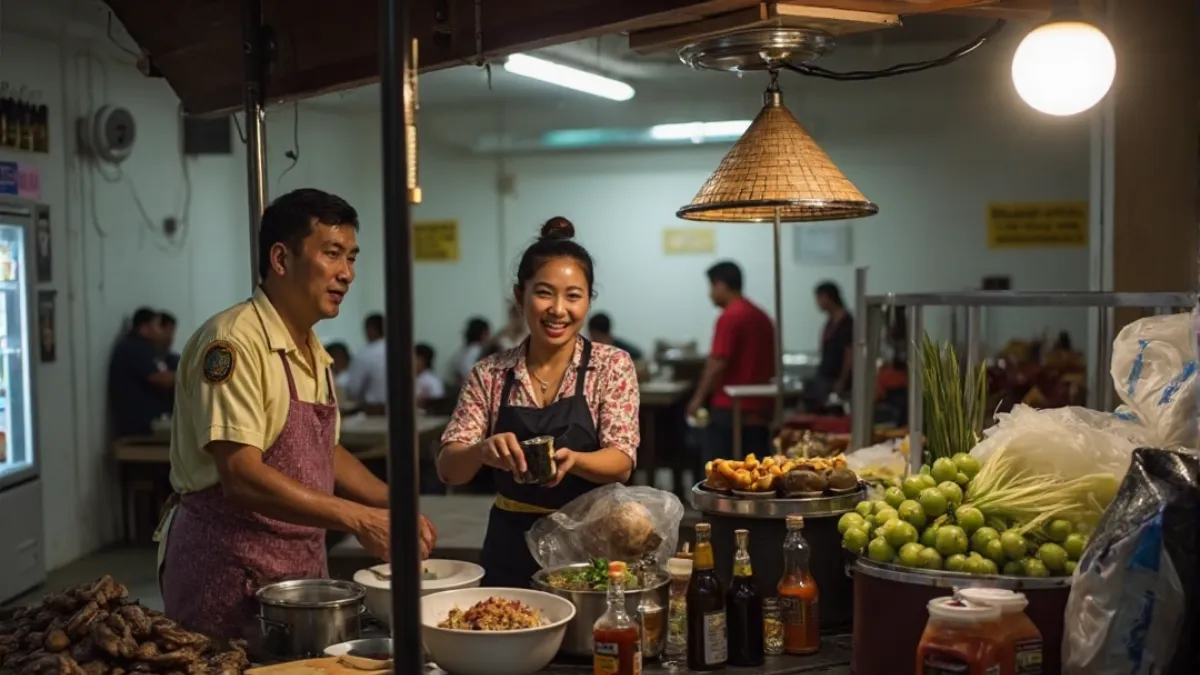In Bangkok’s bustling business districts of Silom, Surawong, and Sathorn, the price of a simple meal has become a stark indicator of Thailand’s growing economic challenges. Over the past 13 years, food prices in these areas have surged by an astonishing 106.5%, rising from an average of 31 Thai Baht (~US$0.87) per dish in 2012 to 64 Baht (~US$1.80) in 2025, according to a recent study by the Agency for Real Estate Affairs (AREA). Meanwhile, the minimum wage has increased by only 33.3%, from 300 Baht (~US$8.40) to 400 Baht (~US$11.20) per day over the same period. This widening gap between living costs and income is placing immense pressure on workers and families across the capital, raising urgent questions about economic equity and government policy.
A Decade of Disparity
The AREA study, which tracked food prices from 2015 to 2025, highlights a troubling trend for Thailand’s urban workforce. In key commercial hubs, where office workers often rely on quick, affordable meals, the cost of eating out has more than doubled. Dr. Sophon Pornchokchai, president of AREA’s research center, spearheaded the survey to gauge how these rising costs impact the public. His findings reveal that while food prices in tourist and industrial zones may climb even higher, basic options in business districts have remained somewhat stable, largely due to consumer sensitivity and periodic government oversight.
However, stability in some areas offers little comfort when wages fail to keep pace. For many low-income workers earning the minimum wage, the daily cost of food now consumes a significant portion of their income. A single dish at 64 Baht represents roughly 16% of a minimum-wage earner’s daily earnings in 2025, compared to just 10% in 2012. This disparity forces difficult choices—between cutting back on meals, seeking cheaper alternatives, or sacrificing other essentials like housing and transportation.
Underlying Pressures: Rent and Economic Slowdown
Beyond the raw numbers, the AREA research points to structural factors driving the price surge. One major contributor is the escalating cost of rent for small businesses, particularly restaurants and food vendors. In Bangkok’s competitive commercial districts, some eateries pay as much as 60,000 Baht (~US$1,680) per month for a mere 18 square meters of space. These high overheads inevitably trickle down to consumers, inflating the price of even the most basic meals.
In response, both vendors and customers are adapting. The study notes a growing shift toward takeaway meals and street food which is often more affordable for diners and less costly for vendors to produce. By reducing the need for dine-in space and service, takeaway options help mitigate some of the financial strain, though they cannot fully offset the broader trend of rising costs.
Compounding these challenges is Thailand’s sluggish economy, which the AREA report suggests will likely keep food price increases in check for the near future. Experts cited in the study predict a modest rise of no more than 2% in food costs between 2025 and 2026. While this forecast offers a glimmer of relief, it also underscores the broader economic stagnation that limits wage growth and consumer spending power. For many families, the advice from researchers is clear: cooking at home may be the most viable way to stretch limited budgets.
The Wage Dilemma: Policy and Politics
The stark contrast between soaring food prices and stagnant wages has reignited debates over Thailand’s labor policies. The minimum wage, which varies by province but averages around 400 Baht per day in Bangkok as of 2025, has long been a contentious issue. Labor advocates argue that incremental increases over the past decade have failed to address the real cost of living, particularly in urban centers where expenses are highest. Meanwhile, business groups and some policymakers caution that rapid wage hikes could burden small and medium-sized enterprises already grappling with high operating costs.
Thailand’s economic landscape has been shaped by a series of governments over the past 13 years, each with differing approaches to wage and price controls. The AREA data, which spans multiple administrations, shows that food prices have risen consistently regardless of political leadership, suggesting that deeper systemic issues—such as supply chain inefficiencies, import dependencies, and urban rent inflation—may be at play. While government interventions have occasionally stabilized basic food prices, they have not closed the gap between earnings and expenses for the average worker.
This disconnect raises critical questions about the effectiveness of current economic policies. Thailand’s economy, heavily reliant on tourism and exports, has faced repeated shocks in recent years, from global pandemics to geopolitical tensions affecting trade. These external pressures, combined with domestic challenges like an aging population and uneven regional development, limit the government’s fiscal room to maneuver. As a result, initiatives to raise the minimum wage or subsidize food costs often face resistance or delay, leaving workers to bear the brunt of inflation.
Impact on Bangkok’s Workforce
For the thousands of office workers, street vendors, and service industry employees in Bangkok’s business districts, the rising cost of food is more than a statistic—it’s a daily struggle. Areas like Silom and Sathorn, known for their gleaming skyscrapers and bustling lunch crowds, are home to a diverse workforce, many of whom commute long distances from more affordable suburbs. The added burden of expensive meals in these districts exacerbates their financial strain, particularly for those supporting families on a single income.
The cultural significance of food in Thailand adds another layer to this issue. Meals are not just sustenance but a cornerstone of social life, often shared with colleagues or family. As prices climb, however, communal dining becomes a luxury for some, pushing workers toward cheaper, less nutritious options or solitary takeaway meals. This shift subtly erodes the social fabric of urban communities, where shared lunches once fostered camaraderie and connection.
Moreover, the disparity in living costs between Bangkok and rural areas highlights broader inequalities within Thailand. While food prices in the capital have doubled, rural workers often face lower costs but also lower wages, limiting their ability to relocate or seek better opportunities. This urban-rural divide complicates national efforts to address inflation and wage stagnation, as policies tailored for one region may not suit another.
Phuket: A Contrasting Island Economy
While Bangkok’s urban workforce grapples with the rising cost of food and stagnant wages, the picture in Phuket tells a different, though equally nuanced, story. Known for its tropical beaches and thriving tourism sector, Phuket presents both higher living costs and a unique economic resilience. According to Karel Engelbrecht, a Phuket-based real estate buyers’ agent, “The cost of living is high in Phuket, however the vast majority of people living here can easily afford the tropical island lifestyle.” Engelbrecht adds that “even the Phuket locals and those that have traveled from Isaan to live and work here seem to get by quite well,” suggesting that despite visible economic pressures, day-to-day life remains manageable for many.
Estimates place the average monthly cost of living for a (Thai) single income (comfortable lifestyle) home in Phuket between ฿12,000 and ฿65,000, with variables like housing and leisure driving much of the variance. A family of four typically faces expenses nearing ฿50,000 excluding accommodation. Though these figures reflect a higher cost base than much of the country, income levels—especially for foreigners and skilled professionals—tend to be higher as well, ranging from ฿50,000 to ฿250,000 per month, with senior executives earning significantly more.
“There is no question that some struggle,” Engelbrecht acknowledges, “but from all indications, the economy is doing reasonably well. Despite some shakiness from Trump’s tariffs, and occasional political issue, buyers are still flocking to the island.” This influx of investment and tourism helps buffer the local economy, keeping demand for goods, services, and labor relatively stable, even amid global uncertainty.
However, while Phuket may appear more economically buoyant than Bangkok in some respects, the island’s reliance on external factors—like tourism, foreign investment, and global trade—makes it vulnerable to shocks. As with other parts of Thailand, the long-term challenge lies in balancing growth with equity, ensuring that rising costs do not outpace the means of those who keep the island running.
Isaan Has Achieved Slow and Sparse Growth
According to Visual Thailand, per‑capita income in rural Isaan hovers around just US $2,000 per year—or roughly 5,800 Baht per month, which breaks down to about 190 Baht a day to cover all expenses. With such limited income, staples like sticky rice, seasonal vegetables, and homemade meals are the backbone of survival. Isaan’s poverty is entrenched. A 2022 World Bank report pegged the national poverty rate at 6.8 percent, but a staggering 79 percent of the poor live in rural areas—mostly in the northeast—where incomes are just 68 percent of urban levels. Average rural household earnings in the Northeast remain the lowest in the country, with limited education, high dependency ratios, and precarious living conditions.
A typical day in one of Isaan’s poorest provinces, like Nong Bua Lamphu, where work is hard and long, illustrates this scarcity. Annual incomes there average about 41,000 Baht (~US $1,160), meaning less than 9,000 Baht per quarter to manage food, essentials, school fees, and health care. The economy remains dominated by low-yield agriculture—rice on poor soil, sugarcane, cassava—with thin profit margins. Less than a quarter of regional GDP comes from agriculture, even though around 85 percent of households depend on it.
Despite the hardships, rural communities have found coping strategies. Many cultivate kitchen gardens—growing bananas, chilies, herbs—to augment their diets without spending cash. Barter exchanges help fill gaps, and entire families often pool resources or rely on remittances from migrants working in Bangkok or abroad to make ends meet.
Looking Ahead: Stability or Stagnation?
As Thailand navigates these economic headwinds, the AREA study offers a cautious outlook. The projected stability in food prices for 2025–2026, while welcome, is rooted in economic sluggishness rather than robust growth or policy success. For workers and families, this means little immediate relief from the cost-of-living crunch. The advice to cook at home, though practical, may not be feasible for those with long working hours or limited access to affordable ingredients in urban markets.
Addressing the wage-price gap will require more than short-term fixes. Economists and labor experts argue for a multi-pronged approach: targeted wage increases for low-income sectors, subsidies or tax breaks for small food vendors, and urban planning reforms to curb rent inflation in key districts. Without such measures, the risk of social discontent grows, as does the potential for wider economic inequality.
Thailand stands at a crossroads. As food prices continue to outstrip wage growth, the resilience of its people is being tested. Whether policymakers can bridge this divide remains uncertain, but the stakes are clear. For now, Bangkok’s workers tighten their belts, hoping for a future where a simple meal doesn’t come at such a steep cost.















